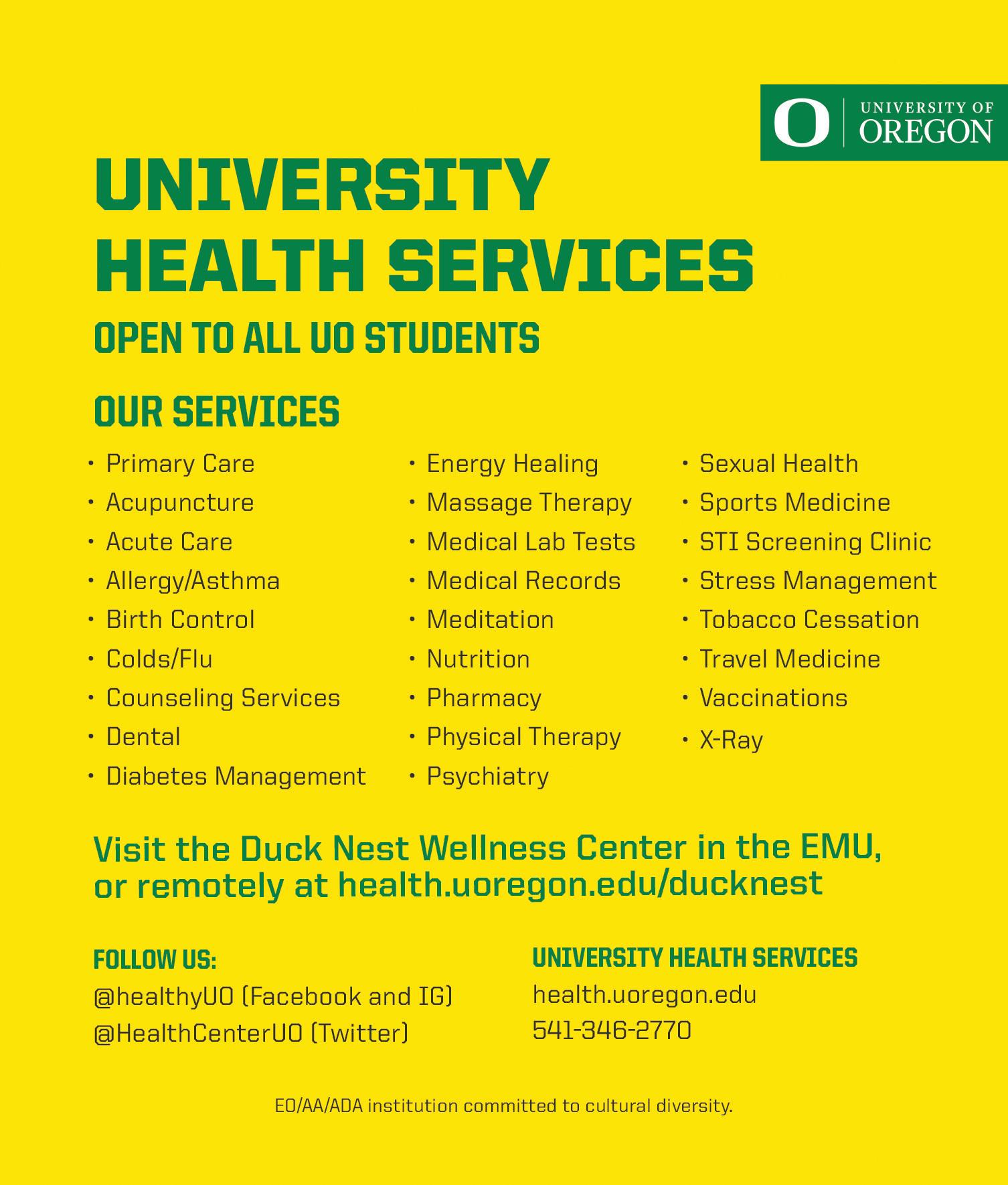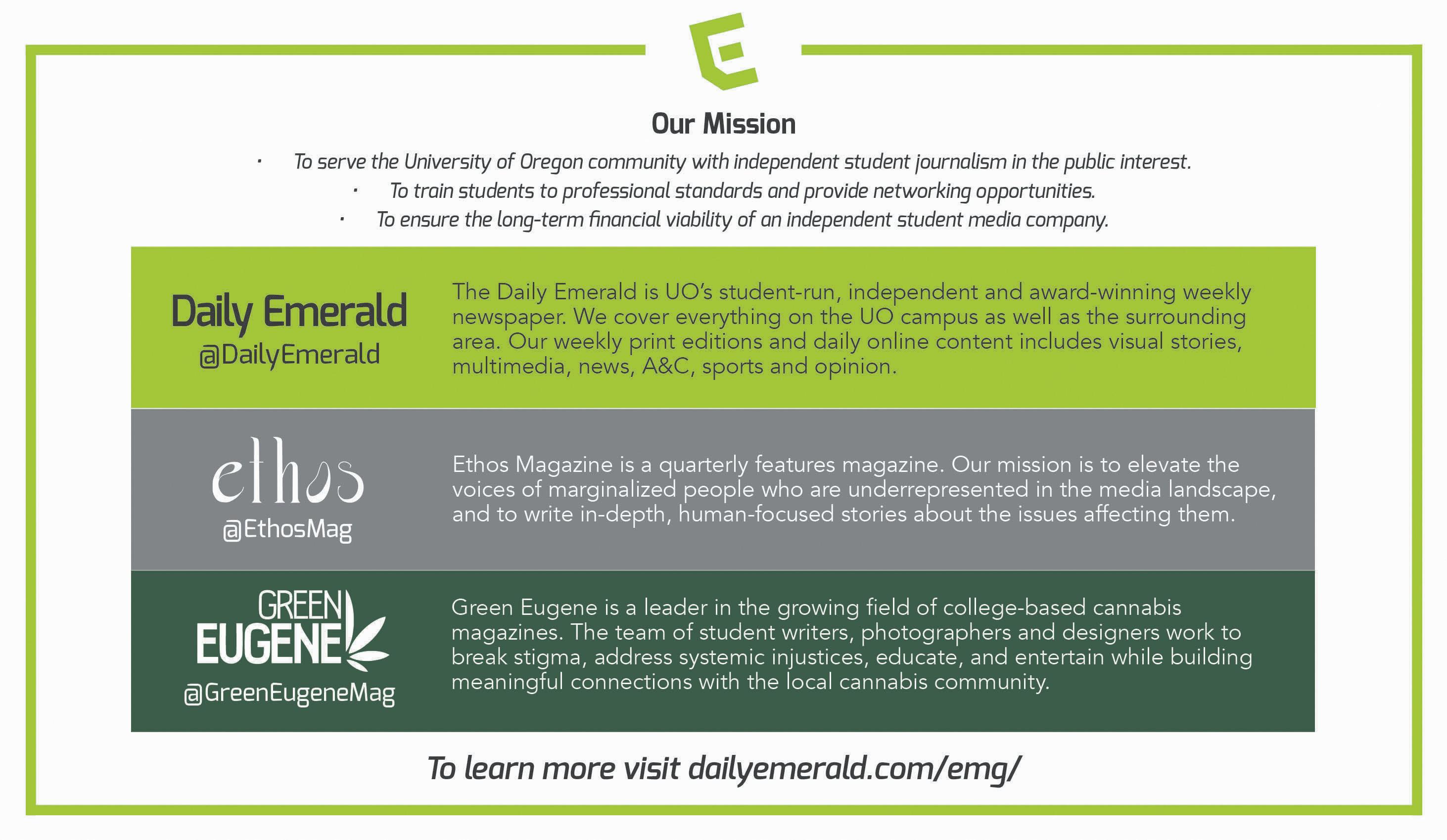
THURSDAY, APRIL 6, 2023 EMERALD | PAGE 1 Week of Welcome Edition NEWS: UPCOMING COUNTY STABILIZATION CENTER AIMS TO FILL GAPS IN SERVICES PG 4 • A&C: HOW THE OUTDOOR PROGRAM SEEKS TO REDEFINE OUTDOORSY WITH A $10K GRANT PG 14 • SPORTS: RUTH: THE EXPERIENCE OF COVERING A SMALLER TEAM PG 23 APRIL 6, 2023 Emerald Media COMBATTING A RISE IN SUICIDE As a new report shows a rise in Lane County suicides, community members and organizations continue the fight against it.

PAGE 2 EMERALD | THURSDAY, APRIL 6, 2023
NEWSROOM
EDITOR IN CHIEF
Hannarose McGuinness
PRINT MANAGING EDITOR

Brandon Roth
DIGITAL MANAGING EDITOR

Sarah Matlick
NEWS EDITORS
Alexis Weisend
Gavin Gamez
Caleb Barber
A&C EDITORS
Krista Kroiss
Evan Reynolds
SPORTS EDITORS
Aaron Heisen
Mojo Hill
OPINION EDITORS
Emma J Nelson
Sophia Cossette
PHOTO EDITOR
Maddie Stellingwerf
SENIOR PHOTOGRAPHER
Ian Enger
DESIGN EDITOR
Liz Blodgett
COPY CHIEF
Amanda Lurey
ASSOCIATE COPY EDITORS
Dylan Farrell
Logan Robertson
VIDEO EDITOR Troy Munson
PODCAST EDITOR
Jamie Diep
SOCIALS EDITOR
Jennifer Singh
VISUALS EDITOR
Julia Stalnaker
BUSINESS
PUBLISHER & PRESIDENT
Bill Kunerth X317 bkunerth@dailyemerald.com
VP OPERATIONS Kathy Carbone X302 kcarbone@dailyemerald.com
DIRECTOR OF SALES & DIGITAL MARKETING
Shelly Rondestvedt X303 srondestvedt@dailyemerald.com
CREATIVE & TECHNICAL DIRECTOR
Annie Smith X327 creative@dailyemerald.com
STUDENT SALES MANAGER
Amy Mendez
ACCOUNT EXECUTIVES
Riley Valle
Keaton Roberts
Max Goldenberg
Josh Delapena

ON THE COVER
Located on Charnelton St., in Eugene, Ore. the Lane County Health

FOR YOU
LOOK ONLINE
Editor Recommends
BY BRANDON ROTH
BOOK RECOMMENDATION: “MILDRED PIERCE” BY JAMES M. CAIN
Summary: I recommend the novel “Mildred Pierce” by James M. Cain. Taking place in 1930s Glendale, California— a city located nine miles north of Los Angeles— Mildred Pierce is a struggling housewife trying to support her family. Her husband recently divorced her and she is left trying to fend for her spoiled daughters. Although she manages to create a business out of her skill of baking pie, her inner circle tries to take advantage of her success through deception and crime. Although she faces many sabotages, you will have to read to find out how she overcomes her adversities. There is also a 1945 noir film starring Joan Crawford that is also highly recommended.
By Lauren Leone
(Kai Kanzer/Emerald)
Second most read story in the past week:
“Welcome back: Oregon’s star sprinter Micah Williams” by Keiji Patterson

(Molly McPherson/Emerald)
Voices of UO
on social media?”
Do you want your voice heard literally? Scan here to respond to our Voices of UO prompt with a brief voice message, and head to www. dailyemerald. com/ multimedia/ podcasts/ next week to listen to the replies!

We want to hear from you:
(Maisie Plew/Emerald)
For updated coverage of sports and digital-exclusive content, go to www.dailyemerald.com


THURSDAY, APRIL 6, 2023 | EMERALD | PAGE 3
and Human Services building is one of the many location for Lane County citizens to seek help. (Maddie Stellingwerf/ Emerald) VOL . 124, ISSUE NO. 68 GET IN TOUCH EMERALD MEDIA GROUP 1395 UNIVERSITY ST., #302 EUGENE, OR 97403 541.346.5511 Daily Emerald THE DAILY EMERALD The Daily Emerald is published by Emerald Media Group, Inc., the independent nonprofit media company at the University of Oregon. Formerly the Oregon Daily Emerald, the news organization was founded in 1900.
Email editor@dailyemerald. com to submit a tip or a letter to the editor. The ideal length for a letter is 200-500 words, but we publish letters of various lengths online. We want to hear from you: Top viewed story in the past week: “Fisherman’s Market brings the flavors of the Pacific Northwest to Eugene with the freshest seafood around”
Scan here or visit the Emerald’s social media to participate in our next Voices of UO. “Who are your favorite news companies that you follow
(Photo courtesy of Brandon Roth)
UPCOMING COUNTY STABILIZATION CENTER AIMS TO FILL GAPS IN SERVICES
UPCOMING COUNTY STABILIZATION CENTER AIMS TO FILL GAPS IN SERVICES
The progress of the new Lane County Stablization Center has entered the stage of purchasing a site and finalizing development blueprints after the project has been worked on since 2014. BY ETHAN DONAHUE
With increasing mental health issues impacting the Lane County community, Lane County Behavioral Health Services has developed a plan to provide mental health aid to those in need.
The Lane County Stabilization Center plan was designed to address the behavioral health crisis and effects of rising homelessness rates in Lane County, which has one of the highest homeless per capita rates in the nation.

“First and foremost, we need the UO community to be aware of the current crisis our community is in when it comes to behavioral health needs and how the stabilization center will help to address at least part of that crisis,” Public Information Officer for Lane County Health and Human Services Jason Davis said.
Davis said Lane County has a severe shortage of behavioral health providers, resulting in a significant barrier to those who need care the most. The stabilization center will fill that gap immediately and provide 24/7 crisis care for anyone in Lane County who is experiencing a behavioral health crisis, he said.
There are concerns drawn from the behavioral health crisis about the public safety of residents and businesses, as well as the stress it places on emergency services. Neither the public nor the emergency services are prepared to provide the support necessary for those who need it, according to the Lane County Stabilization Center team.
The four pillars of the 2022-2024 strategic summary for the LCSC are promote equity and decrease disparity, focus on community health and well-being with a focus on those with the highest needs, strengthen a supportive infrastructure and focus on our people.
The solution presented by LCBH is to build a 24/7 behavioral health stabilization center that would provide an immediate assessment, behavioral health services, connections to specialty, long-term support and aided discharge. Aided discharge offers continued mental support and check-ins to patients re-entering the community.
The entire process would focus on providing person-centered help with dignity, respect, choice, self-determination and a purposeful life according to the LCSC website.
“We will see people who are considering suicide have a place to go anytime of the day or night, and have someone to talk to and to get help from,” Davis said. “We will see people who are forced into living on the street due to a behavioral health issue finally get the help they need for the root cause of their houselessness.”
There would be four main ways to enter the center: referrals from health and social service providers, voluntary walk-ins, mobile crisis drop-offs and law enforcement drop-offs.
The law enforcement drop-offs would be in the place of an arrest and would happen via a separate entrance. A Mobile Crisis Assessment Team, which would respond to emergency calls for those experiencing mental health crises without involving law enforcement, could execute the mobile crisis drop-offs.
The LCSC project vision came together in 2014 and the project progressed through 2020 when Operational Development began. By late 2022 and into early 2023, funding, community engagement, site selection and the development design and began.
“We are looking at a potential opening around winter 2025 and are hopeful that as we pursue this important project, our community joins us in tackling the hurdles that will inevitably be presented,” Davis said.
There hasn’t been a finalized decision on where the center will be built, but one spot that has been mentioned during past meetings was behind the Lane County Behavioral Health Services clinic on Martin Luther King Jr. Boulevard because of its proximity to other health resources and the fact that the land is already owned by the county.
According to its website, LCSC is projected to have the capacity to serve 42 individuals at a time and projects that over 8,200 individuals would be served annually. There will be 16 adult short-term stabilization beds, 12 youth beds and 14 adult respite beds.
The only other center like this in Oregon is in Bend. The center opened parttime in June 2020, and it served 325 people, with 464 visits within four months.
Twenty percent of clients were diverted from emergency rooms, and another 16% were brought to the center by local law enforcement, according to the plan. The center was then given a $2.4 million state grant to support 24/7 operations. This funding has continued, and the center has increased the amount of people helped, according to statistics provided by the Bend Stabilization Center.
Davis believes that a Lane County center would mean a better quality of life for everyone who lives in Lane County.
PAGE 4 EMERALD | THURSDAY, APRIL 6, 2023
NEWS
Several cars pass by makeshift tents as the houseless individuals begin their day. A community of houseless individuals reside underneath Coburg Road in Eugene, Ore., on May 5,2021. (Ali Watson/Emerald)




THURSDAY, APRIL 6, 2023 EMERALD | PAGE 5

PAGE 6 | EMERALD | THURSDAY, APRIL 6, 2023




THURSDAY, APRIL 6, 2023 | EMERALD | PAGE 7
HOBBS: FOOD DELIVERY APPS SUCK

Opinion: Customers and delivery drivers both receive the short end of the stick as the multi-billion dollar market continues to grow.
BY MONICA HOBBS
(Regan Nelson/Emerald)

The food delivery industry rapidly expanded in the past decade and the pandemic contributed to this, more than doubling the market in the United States. With a global market worth around $150 billion, much of the U.S. population has used DoorDash, Grubhub, Postmates or Uber Eats at least once. However, I can confidently say that delivery apps are flawed in countless ways.
In a survey by Circuit, nine out of ten customers have had a food delivery order go wrong. Some received their order past the expected delivery time, resulting in cold food. Others had their order canceled at the last minute. I’ve experienced the extreme where my driver stole my food — multiple times.
Besides how the inefficiency makes my blood boil, the cost of delivery is outrageous. Delivery platforms make their revenue through five methods: restaurant commission fees; customer delivery fees, ranging from $2 to $5 per order; customer-service fees; in-app advertising, and driver tips. All of these fees make a $10 order add up to $25 in the blink of an eye.
To add to the large cost, customers don’t realize delivery apps charge up menu items. You heard me right, prices are higher on delivery platforms than on the actual menu. For example, Grubhub lists a Big Mac Meal as $10.10, compared to the restaurant price of $8.75. That’s a 13% upcharge.
Unfortunately, the grass isn’t greener on the driver’s side of food delivery. I worked as a Doordash driver during the pandemic. As an 18-year-old, I quickly learned that the delivery service was corrupt.
Delivery platforms’ revenue is incomparable to the drivers’ pay. According to DoorDash, their base pay ranges from $2 to $10. In reality, most orders are $6. This forces drivers to rely heavily on tips. Yet most customers don’t tip dashers due to the already overwhelming fees. By the end of a workday, the gas mileage roughly breaks even with revenue, resulting in little-to-no profit.
Doordashing as a young woman also prompted many safety risks. Delivery services often lead their drivers to distant locations. There were numerous occasions when I ended up in sketchy areas in the dark with no phone service. There were other times when older men texted me after completing the order
saying, “You’re so beautiful.” Ultimately, your age and gender are irrelevant — delivery jobs are dangerous.
My last issue with the delivery service is the blame game. In a survey, 59% of respondents admitted to confronting their drivers in the event of poor delivery. If a dasher acts irresponsibly, that’s on them. However, there are outside factors most of the time, such as the restaurant running late or a far delivery distance. Drivers are independent workers receiving below minimum wage; they deserve respect.
So the food delivery industry is insufficient... now what? Addressing the delivery platforms is the first step. DoorDash, Grubhub, Postmates and UberEats are all markets that have fallen to capitalism. They operate for themselves, rather than serving their employees and customers. Christopher Payne, then-DoorDash COO — now president — told the Wall Street Journal, “This is a cost-intensive business that is low-margin and scale driven.” Their main focus is to grow and improve profit margins.
Restaurants risk losing loyal customers from poor delivery experiences. In response, restaurants have begun adopting online menus and QR codes. To avoid overpriced food and driver exploitation, consider ordering directly from a restaurant. Call for take-out, or maybe eat there and throw in an extra tip for the server. Delivery platforms have a long journey before they earn customer loyalty.
PAGE 8 | EMERALD | THURSDAY, APRIL 6, 2023 OPINION
Monica Hobbs is an opinion columnist for the Daily Emerald. She is a third-year student from San Jose, majoring in journalism and business. Monica hopes to share opinions on the intersectionality of culture and social justice.

THURSDAY, APRIL 6, 2023 | EMERALD | PAGE 9




PAGE 10 | EMERALD | THURSDAY, APRIL 6, 2023
TAPIA’S TAKE:
BY CAITLIN TAPIA
TO GIVE UP ON PRINT NEWSPAPER IS TO GIVE UP ON JOURNALISM
People increasingly consume their news through their phones or other devices. This focus on online news, while somewhat beneficial, also aids the spread of fake news. This could be avoided if we returned to a focus on print news and bring it back to life.
a wildfire on both social media platforms and news organizations. On social media, people posted Tweets rumoring about alleged suspects and victims of the attack, many of which were proven to be untrue. In the news, organizations including CNN, Fox News, The Associated Press and more reported that an arrest had been made until later corrected by the FBI.
That readily available access to the internet and simple technologies not only makes it easier for legitimate news organizations to produce and share content, but it also makes it easier for the creation and spreading of fake news.
Besides just false reports of breaking news, there are dozens, if not more, entire websites designed to “report” fake news. These websites look convincingly similar to trusted news organizations and, without a careful eye, would be mistaken for one.
And as it turns out, not many people have that careful eye. A study published in the Proceedings of the National Academy of Sciences found that 75% of people overestimate their ability to recognize fake news. The problem with this is that these people are also the most likely to visit these fake news websites and share its content, creating a never-ending cycle of the spread of false information among people who are unable to detect it.
This is where print publications come into play.
As far as I’m aware, there are no print publications designed to share fake news. You know that when you go to pick up a copy of the day’s paper that it is from a reputable source. The issue is then, how do we go about increasing the amount of people who revert back to print publications?
When I was younger, my grandparents used to have a bin full of that week’s newspapers and magazines next to this big comfy chair right by the fireplace. That bin isn’t there anymore, but as I pulled into their driveway recently, I saw the little red bag sitting there with the day’s paper. They are the only people I know who still get the paper delivered to their house regularly. My family occasionally got it when I was younger, but like most people, we have transitioned to getting most of our news online.
According to data from Pew Research Center from 2021, 86% of people said they got their news from a smartphone, computer or tablet compared to only 32% of people who said they got their news from a print publication.
This comes as no surprise, though. Why would you pick up a physical paper when you could just open an app on your phone that you were probably already on? Sure, it’s more convenient, but there is something timeless about newspapers, and I think it’s time to reinvent and re-establish their position in the journalism industry.
While the concept of newspapers can be traced all the way back to the Romans, modern news printing truly got its start with the invention of the printing press in 1440. Fast forward a few centuries of government censorship and increases in print technology to 1833 and the beginning of the penny press: Papers sold just for a penny by The Sun. The penny press rapidly increased the speed and capacity for newspaper production –– marked by The Sun’s goal to “lay before the public, at a price within the means of every one, all the news of the day, and at the same time offer an advantageous medium for advertisements.”
Skip ahead another few centuries to today, and one is now in an age where readily available access to the internet and simple technologies allows for the news to be delivered at a moment’s notice.
This may be the only feature of online news I enjoy and find beneficial; being able to be in the know when something happens almost instantaneously. That being said, it isn’t without faults.
In 2013, after the Boston Marathon bombing, misinformation spread like
I think there are two possibilities: make it more engaging and target younger audiences.
On the first point, newspapers can seem so dense with information sometimes. A paper filled with nothing but tiny print and a few photos here and there is not engaging. That’s not to say we scrap the model altogether, but there should be an increase in puzzles, games and potentially comics in papers, particularly if the paper doesn’t have them to begin with. Personally, I am much more likely to pick up a copy of the paper if I know there is a Sudoku or crossword puzzle in there. It serves as motivation to read till that page and then acts as a break in articles before continuing on.

Secondly, and this ties into making newspapers more engaging, newspapers aren’t targeted towards younger audiences, but it wouldn’t be hard to do so. Not only would making the paper more engaging potentially drive more young folks to pick up a copy, but Gen Z loves to bring back trends, and this could be one of them.
Gen Z has already brought back a ton of trends including wired headphones and fashion from the ‘80s and ‘90s, in part due to popular TV shows and movies such as “Stranger Things” and “Top Gun.” I see no reason as to why print newspapers cannot become one of these trends with the generation’s love for nostalgia.
I refuse to accept that our industry is ready to let print news die rather than making a few simple and easy strategies, especially in a time in which fake news so heavily influences people’s beliefs and fuels distrust in journalism.

THURSDAY, APRIL 6, 2023 | EMERALD | PAGE 11
OPINION
Caitlin Tapia is an opinion columnist for the Daily Emerald. She is a senior from Colorado majoring in journalism and political science. She is most passionate about social justice and politics but will also write about her bike being stolen.
One of the newspapers blown onto Johnson Hall’s steps reports of arrests at then-recent anti-racist protests in Portland and wildfires across Oregon during 2020. The Eugene-Springfield area was filled with ash and smoke due to the Holiday Farm Fire. (Summer Surgent-Gough/Emerald)
LOCAL SERVICES COMBAT LANE COUNTY’S HIGH RATE OF SUICIDE
LOCAL SERVICES COMBAT LANE COUNTY’S HIGH RATE OF SUICIDE
A new report from the Lane County Health and Human Services Department shows an alarming increase in deaths by suicide over the last 20 years. But it’s being countered by an increase in support resources.
BY MATHIAS LEHMAN-WINTERS
An 80% increase in suicides and 1,458 deaths by suicide in Lane County over the course of 20 years — these are the latest figures from the Suicide in Lane County report published on Feb. 7.
The report, which draws on data from between 2000 and 2020, reveals the rate of suicide in Lane County was 65% greater than the U.S. average. Nearly
one in four of people who died by suicide were veterans or military service members. Suicide rates typically rise in the spring months for reasons not entirely known.
Roger Brubaker, a Lane County Public Health suicide prevention coordinator and the author of the report, said the causes for Lane County’s particularly
80% increase in Lane
•••••••••••••••••••••••••••••••••••••••••••••••••••••••••••••••••••••••••••••••••••••
•••••••••••••••••••••••••••••••••••••••••••••••••••••••••••••••••••••••••••••••••••••
•••••••••••••••••••••••••••••••••••••••••••••••••••••••••••••••••••••••••••••••••••••
••••••••••••••••••••••••••••••••••••••••••••••••••••••••••••••••••••••••••••••••••••• ••••••••••••••••••••••••••••••••••••••••••••••••••••••••••••••••••••••••••••••••••••• ••••••••••••••••••••••••••••••••••••••••••••••••••••••••••••••••••••••••••••••••••••• ••••••••••••••••••••••••••••••••••••••••••••••••••••••••••••••••••••••••••••••••••••• ••••••••••••••••••••••••••••••••••••••••••••••••••••••••••••••••••••••••••••••••••••• ••••••••••••••••••••••••••••••••••••••••••••••••••••••••••••••••••••••••••••••••••••• ••••••••••••••••••••••••••••••••••••••••••••••••••••••••••••••••••••••••••••••••••••• ••••••••••••••••••••••••••••••••••••••••••••••••••••••••••••••••••••••••••••••••••••• ••••••••••••••••••••••••••••••••••••••••••••••••••••••••••••••••••••••••••••••••••••• ••••••••••••••••••••••••••••••••••••••••••••••••••••••••••••••••••••••••••••••••••••• ••••••••••••••••••••••••••••••••••••••••••••••••••••••••••••••••••••••••••••••••••••• ••••••••••••••••••••••••••••••••••••••••••••••••••••••••••••••••••••••••••••••••••••• ••••••••••••••••••••••••••••••••••••••••••••••••••••••••••••••••••••••••••••••••••••• ••••••••••••••••••••••••••••••••••••••••••••••••••••••••••••••••••••••••••••••••••••• ••••••••••••• Each dot represents 1 death. Green Dots representing the veterans or service members.
PAGE 12 | EMERALD | THURSDAY, APRIL 6, 2023 COVER
1,458 deaths reported. Nearly 1/4 being veterans or service members
County suicides over first 20 years of the century 65% higher than the US average
high suicide rate cannot be chalked up to a single reason. However, he said one of the possible reasons could be that Lane County is a rural county, and, on average, rural communities experience more deaths by suicide.
Cities such as Junction City and Cottage Grove experience a suicide mortality rate more than twice that of more urbanized Eugene, Brubaker said. This is due to a variety of reasons, he said, ranging from difficulty obtaining mental health services because of cost and distance to a stigma around mental health that can be more prevalent in rural communities.
However, as with many other fields, there are simply not enough workers to fill the necessary positions within the healthcare system.
“Within our healthcare system, we’re currently in the state experiencing a very significant workforce shortage,” Brubaker said. “Meaning that our healthcare system is actually not terribly well prepared locally or at the state level to provide sufficient care for people with health problems.”
The health care and mental health support systems in both Lane County and Oregon at large have been placed under great strain in recent years, according to a 2018 report by the Oregon Health Authority. Oregon ranks 30th in the nation in regard to access to healthcare, 48th in adult mental illness and last in relation to prevalence of mental illness and access to services among youth, according to the nonprofit Mental Health America.
This means while the healthcare system may be sufficiently funded, it is overwhelmed by the vast number of Oregonians in need.
However, Lane County has increased the budget for the Lane County Department of Health and Human Services by over $70 million in the past decade, from about $104 million to nearly $175 million, according to Lane County’s website. These budget increases have led to more funding for two major mental health services: the Behavioral Health Services and the Community Health Services.
Dawn Lesley, a citizen member of the Lane County Budget Committee for the 2022–23 budget, said the budget for the Department of Health and Human Services makes up nearly 18% of the entire county budget.
Lesley said access to healthcare and mental healthcare were one of the county’s top concerns.
“The budget is the truest expression you can get on the relative priority of things,” Lesley said.
While county administrators grapple with managing mental illness and trying to reduce deaths by suicide, many local organizations have also been committed to helping. The GriefShare group, a grief recovery support group located at Cove Church in Eugene, is one of these organizations.
Jan Hahn was one of the many people who benefited from the listening and community at GriefShare. In 2015, she lost her son to suicide, then just four years later, in 2019, her daughter passed away from cancer.
After losing her only children, Hahn said she felt alone and as if she no longer had a purpose in life.
“Losing a loved one after a long, painful illness is heartbreaking, knowing there is nothing you can do to help except be by their side and hold their hand,” Hahn said. “But losing a loved one to suicide is devastating. You had no idea life was so painful for them, and they hid their mental anguish from you.”
Hahn said she was grateful for the community and comfort that GriefShare provided in her darkest hours. When someone loses a loved one or friend to suicide, it is important to have a group there to support each other says Hahn.
“Friendships change when tragedy strikes. People you think will always be there are not,” Nina Charlson, the lead facilitator at GriefShare said. “New friendships are formed in these groups. Having supportive friends is vital to healing.”
Community healing is critical for suicide survivors in its aftermath. However, a supportive community is also important as a preventative measure, Burbaker said. If people want to take steps to improve mental health, it is incredibly important to take a more community-centric approach to mental health support, he said.
Burbaker said he believes one of the most important ways the community can help reduce deaths by suicide is by providing a supportive environment for those in need.
Suicide prevention is far from only a Lane County issue. Oregon legislators heard testimony on Senate Bill 818 and 514 on Feb. 13 — bills that, if passed, would direct the Oregon Health Authority to do a suicide risk assessment and provide education opportunities for healthcare providers in regard to suicide. It also establishes a Adult Suicide Prevention Coordinator within the Oregon Health Authority, a position dedicated to adult suicide prevention.
Brubaker said he believes these are steps in the right direction.
“When we think about suicide, we think about the health of our community, not just the health of an individual,” he said.
Brubaker points to SB 52, more commonly known as Adi’s Act, that was passed in 2019 as crucial in combating suicide. Adi’s Act requires school districts to develop a plan for suicide prevention, intervention and post-vention response activities.
“We can state at this point that every single educator in the county has essentially, over the past three years, received training in suicide intervention skills, and we’re really proud of that,” Brubaker said.

Brubaker said this in relation to the work that the Lane County Public Health Department has done in helping to implement Adi’s Act through strategies such as screening, assessment and safety planning practices in schools since the bill’s passage.
Lane County and the University of Oregon provide excellent services for those struggling with mental health or experiencing suicidal thoughts, Brubaker said. In Lane County, there is the Suicide Prevention Coalition, which includes groups such as GriefShare at Cove Church and the 988 Suicide and Crisis Lifeline.
On campus, the University Health Services provide free counseling for anyone and an AfterHours Support and Crisis Line at 541-346-3227.
“Hope is not just an optimistic disposition; it is an action,” the Suicide in Lane County report wrote.
THURSDAY, APRIL 6, 2023 | EMERALD PAGE 13 COVER
1 in 4 deaths by suicide included a veteran (Illustration by Brandon Roth)
Outdoor recreation is an area of interest that has been historically dominated by white, cisgender, heterosexual men. That’s the way the individuals behind the Redefining Outdoorsy initiative at the UO Outdoor Program understand it.
“It’s always been like that, it’s still like that,” Margaret Hoff, director of the Outdoor Program, said. As a young girl, she was often told that she didn’t belong in spaces like the outdoors, and that impacted the work she aims to achieve within the Redefining Outdoorsy initiative. “That has always been something that I strive to do — is make it more welcoming for everybody, no matter how you learn, no matter what you look like, your size, any of those things,” Hoff said.
Redefining Outdoorsy is the Outdoor Program’s commitment to making the outdoors accessible to non-traditional users. Breaking down the barriers that have prevented people from taking up space outdoors in the past creates opportunities for those who may not have them otherwise.
“A lot of people put out diversity and equity statements and don’t really follow that up with action,” Erin McGinnes, Collaborative Program Coordinator at the Outdoor Program said. It’s McGinnes’ goal to utilize the initiative to take action toward creating change for the Outdoor Program at the UO.
McGinnes’ position as the Collaborative Program Coordinator has been rewarding due to the flexibility of the role, allowing her to pursue her passions, specifically equity and justice for people of color.
One of the largest barriers to accessing the outdoors is the funding that is required for the
HOW THE OUTDOOR PROGRAM SEEKS TO REDEFINE OUTDOORSY WITH A $10K GRANT
The Redefining Outdoorsy initiative pursues further funding to help support outdoor recreation for marginalized groups.
BY MIRANDAH DAVIS-POWELL
activities. “Cross-country skiing is expensive. Going climbing is expensive. Even getting a ride to go hiking is expensive, no matter how far away it is,” McGinnes said.

Hoff, as the director, has worked closely with the Collaborative Program Coordinators for the past few years to make progress toward the goals of the Redefining Outdoorsy initiative. According to Hoff, this year she has been working with the Erb Memorial Union to create a $10,000 grant that will repeat in future years to help fund the initiative,
We’re bringing more students in, and it’s going to take time, but we’re on an upward trend. It’s getting better.
ERIN MCGINNES Collaborative Program Coordinator at the Outdoor Program
namely affinity trips that help support the participation of diverse student groups on campus.
According to Hoff, the creation of the grant aligned with the EMU’s mission of continuing to support diversity in their programming, as well as their goal of being anti-racist.
The Outdoor Program receives funding from a variety of organizations, namely Goldman Sachs and Columbia Sportswear, as well as other small programs in Eugene such as the Hilyard Center and Life Cycle, all of which have been essential to the operation of the program. According to Hoff, the new additional $10,000 from the EMU has allowed for the expansion of the initiative
in ways that the program has not seen before. “Overcoming that financial barrier to getting out and doing things is huge,” Hoff said.
It’s allowed larger-scale programming, according to McGinnes. For example, next term BIPOC students will have the opportunity to attend a climbing trip at Smith Rock. “They’re getting out of Eugene, but they’re also making new friends and learning something new,” McGinnes said. “Our program definitely wouldn’t have been able to afford that without money like that.”
Other programs funded through the Redefining Outdoorsy initiative include BIPOC climb nights with Elevation Bouldering Gym, and it has been working on connecting to Academic Residential Communities such as the Black Cultural ARC and working with the Multicultural Center at UO to conduct outreach. The connections that the Redefining Outdoorsy initiative has created extend across all areas of the university.
According to Hoff, it’s been very rewarding to see that their efforts are coming to fruition, but she acknowledges that there is still work to be done. “Different people are walking through the door,” she said.
“I think it’s really amazing that they want to come back and do something that they might have not done before,” McGinnes said, expressing her gratitude for the connections that the affinity trips are able to create. She said that it’s always impactful for her to see individuals return to Outdoor Program events after being introduced to their opportunities to get involved. “We’re bringing more students in, and it’s going to take time, but we’re on an upward trend. It’s getting better,” she said.
PAGE 14 EMERALD | THURSDAY, APRIL 6, 2023 A&C
Photo courtesy of Margaret Hoff.



THURSDAY, APRIL 6, 2023 | EMERALD | PAGE 15

PAGE 16 | EMERALD | THURSDAY, APRIL 6, 2023
A SUMMER OF ESCAPE AND SUPPORT A SUMMER OF ESCAPE AND SUPPORT
University of Oregon students reflect on the impact Camp Kesem has had on them.

 BY ROMIE AVIVI STUHL
BY ROMIE AVIVI STUHL
Camp Kesem is a free summer camp designed for children whose parents have been affected by cancer. The camp provides kids with a week filled with fun activities, allowing them to escape the stresses that may have come with their parent’s illness.
Nolan Smith was 6 years old when his father passed away from lung cancer. His friends at a therapy group suggested he attend Camp Kesem. Since then, he has been a camper for 10 years.
“It’s basically just a place where you can go during the summer and have fun, worry about being a kid again,” Smith said about Kesem.
While attending camp, Smith said he finally felt like he could fit in. He was surrounded by other kids who faced similar experiences to his own and could better understand him.
His favorite memory from camp was attending the empowerment circle. During this event, each camper is given the opportunity to
share why they decided to attend. This often brings up stories about their parent’s battle with cancer and the impact it has on their life.
Smith said the empowerment circles held a different meaning than just sharing his personal struggles. It provided him with a space where he felt heard and understood. The circle was a space of support for him.
It wasn’t until Smith left Kesem that he understood the profound impact it had on him. When choosing what college to attend, it was a priority of his that the school had a Camp Kesem Chapter. The University of Oregon holds one of over 130 Kesem chapters nationally.
In college, Smith held several roles at Camp Kesem. He was a counselor, member of the coordinator board and now serves as one of the co-directors. Smith wanted to ensure other kids continue to receive the same rich experience he had.
“Getting to see the kids happy and having a good time is just the most amazing thing in my mind,” Smith
said.
Smith’s childhood experience is unique, yet many kids have a parent that is affected by cancer. According to Camp Kesem’s website there are about 5 million children that fit into this category in the United States alone.
Corrin Hoyer was 13 when her mother was diagnosed with stage four colon cancer. Within a single day, a single diagnosis, her world turned upside down. She felt angry at her mother’s doctors for not finding the cancer sooner, and she was frustrated at her sister for not being as upset by the situation.
Hoyer was initially hesitant to attend camp. She said she worried it would be a “super sad cancer camp.” However, for the four years she attended she participated in fun activities and found a supportive group of friends.
“It was a really uplifting space,” Hoyer said. “Having a parent who has cancer is really isolating… so finally to not feel isolated about that,
it was nice.”
Today, Hoyer is better known by her Kesem friends as Mango, the camp name she selected for herself. She even has a tattoo of a mango and a tangerine on her right arm. The tangerine symbolizes her sister, who convinced her to go to camp.
Camp Kesem is a nonprofit organization. Students like Smith and Hoyer volunteer their time and host a variety of fundraising activities. Smith said the best way for other students to support the organization is to become a member, attend meetings, help fundraise and donate if they are able to.
Camp Kesem has provided Smith with lifelong friends and a break from the stress that came with his father’s passing. He said he looks forward to once again seeing the kids enjoy a fun week this summer.
THURSDAY, APRIL 6, 2023 | EMERALD | PAGE 17 A&C
During the fashion show, each unit dressed up as their camp counselor. (Photo courtesy of Taylor Holm).
During summer 2022, campers participated in a fashion show. (Photo Courtesy of Taylor Holm.)



PAGE 18 | EMERALD | THURSDAY, APRIL 6, 2023

THURSDAY, APRIL 6, 2023 | EMERALD | PAGE 19
WHERE WILL OREGON’S NFL HOPEFULS LAND IN LATE-APRIL’S DRAFT?

Ducks dive into draft season BY AARON HEISEN • TWITTER @AARONHEISEN
CHRISTIAN GONZALEZ, CB, 1ST RD.
Physical Traits: Standing at 6-foot-2, 201-pounds Gonzalez’s stature is greater than most players who share his position. He ranked No. 6 among cornerbacks clocking a 4.38-second 40-yard dash at the NFL combine. That broad prominence manifests itself in his physical playstyle. He has no problem jamming wide receivers at the line of scrimmage or redirecting their routes. He’s a calculated rusher that rarely overcommitted, and it showed in his five tackles-for-loss as a sophomore at Colorado.
Narrative: Gonzalez’s mom, Temple, said in an interview with the Daily Emerald, “his dream has always been to play in the NFL.” That dream started when Temple enrolled him in a youth football league when he was 5-years-old. His coach at the time, Ray Buckley, was the first to see his talent and said that Gonzalez — who played quarterback for that youth team — could comprehend a playbook and read a defense.
In 2021, Gonzalez was part of a Buffaloes’ defense that ranked No. 11 in the Pac-12 in yards allowed per game and No. 10 in passing yards allowed. It was a situation that overshadowed Gonzalez’s talent so he transferred to Oregon in 2022. He followed Colorado’s defensive back coach Demetrice Martin who was one of head coach Dan Lanning’s first hires. Having already played under Martin, Gonzalez needed no time adjusting to Oregon’s defensive scheme, while acting as an example for his fellow cornerbacks.
NOAH SEWELL, LB, LATE 3RD RD./EARLY 4TH RD.
Physical Traits: Sewell is a typical box-to-box middle linebacker who’s better as a run defender than against the pass. However, at Oregon, he was asked to drop back into coverage more often than not, which, at times, exploited his lateral movement. When the ball-carrier is in front, Sewell breaks down and wraps up fundamentally, using his upper body, rather than just his arms. He stands at 6-foot-2, 253 pounds and clocked a 4.64-second 40-yard dash at the NFL combine.
Narrative: Sewell’s part of a long line of talented
football players. His older brother Penei opted out of his junior season at Oregon to prepare for the NFL draft. In 2021, he was drafted No. 7 overall for the Detroit Lions and started in all 17 games for the Lions at offensive tackle this past season. His other older brother Nephi went undrafted in 2022, after playing at the University of Utah, and signed with the New Orleans Saints as a free agent. His older brother Gabriel plays for the Philadelphia Stars in the United States Football League. Sewell either completely avoids talking to the media or he approaches them in a playful, joking manner. At Oregon, he battled lingering injuries at times but played 14 games in 2021 and 12 this past season. He led the team with 114 total tackles in 2021.
D.J. JOHNSON, DE/OLB,
4TH RD.
Physical Traits: Johnson has the versatility to line up at both defensive end and outside linebacker. At 6-foot-4, 258 pounds, his build is catered to that of a down-lineman, rusher. He’s not afraid to hit anyone, which at times can come off as over-aggressive, but Johnson’s an experienced player at multiple positions which will translate to success in the NFL.
Narrative: Johnson moved around throughout his four-year college career, starting at defensive end, before moving to the offensive side as a tightend, before playing outside linebacker in his senior season. Johnson’s character came into question in the Ducks final regular season game against instate rivals, Oregon State. Following a 38-34 loss, highlighted by the Ducks blowing a 21-point lead, a video surfaced of Johnson punching an Oregon State fan who had rushed the field along with most of the stadium. Oregon investigated the situation, and Lanning said that behavior “would not be condoned.” There was no formal suspension, but Johnson didn’t appear in the following game: The Holiday Bowl.
BENNETT WILLIAMS, DB, 6TH RD
Physical Traits: Williams’ positives lie in his football IQ. What he lacks in physical build as a traditional cornerback or box safety, he makes up for with his smarts. After transferring to Oregon in

2020, he spent most of his time at star corner and box safety, playing underneath deep safeties such as Bryan Addison, Steve Stephens and now-Miami Dolphins’ Verone McKinley. Apart from covering slot receivers and tight-ends, Williams’ greatest physical trait is his ability to make downhill tackles, and wrap-up ball carriers regardless of their stature.
Narrative: Williams’ collegiate career began at the University of Illinois in 2017. He was suspended for the first three games of the Illinois’ 2018 campaign for violating team rules, according to the “Herald & Review.” He then left their Week 4 game against Penn State with a hamstring injury and missed the remainder of the season. He spent 2019 playing at the College of San Mateo before transferring to Oregon in 2020. Injuries became an overarching theme of his career, as he appeared in just five games in 2021. But a healthy season in 2022 saw Williams lead the Ducks with 72 total tackles. In addition, his two-interception game against the Utes helped keep the Ducks’ Pac-12 title hopes alive.
MALAESALA AUMAVAE-LAULU, OT, 6TH RD.
Physical Traits: Widely-known as “Sala,” the 6-foot-6 right tackle anchored an Oregon offensive line that conceded just five sacks in 2022 and was ranked in the top-5 on pro football focus for the majority of the season. Along with their ability to protect the quarterback, the offensive line boosted the Ducks to being the Pac-12’s No. 3 rushing attack, one spearheaded by Mar’keise Irving (1,058 yards) and Bo Nix (510 yards).
Narrative: Sala was one of four seniors on the Ducks’ offensive line alongside junior Dawson Jaramillo. He started 14 games in 2022 and played a team-high 902 snaps. His college career started at Navarro College, in Corsicana, Texas, where he played two seasons before transferring to Oregon in 2019. He redshirted that year and started six games in 2020, barely missing any snaps from that point until he graduated.
PAGE 20 EMERALD | THURSDAY, APRIL 6, 2023 SPORTS
1st round prospect, Christian Gonzales, performs a catching drill to show off his abilities. (Jonathan Suni/Emerald)
Oregon safety, Bennett Williams, and Oregon cornerback, Christian Gonzales, warm up together before participating in a drill. (Jonathan Suni/Emerald)


THURSDAY, APRIL 6, 2023 | EMERALD PAGE 21



PAGE 22 | EMERALD THURSDAY, APRIL 6, 2023
RUTH: THE EXPERIENCE OF COVERING A SMALLER TEAM
I’ve been covering the Oregon women’s tennis team for two seasons now. It doesn’t have some of the same glamor as football, but I wouldn’t trade it.
BY BRADYRUTH • TWITTER @BRADYRUTH10
Oregon is a well-known sports brand with nationwide recognition and fanbase. This shouldn’t come as a surprise to anyone. But when people think of Oregon athletics, women’s tennis doesn’t jump off the page. Maybe the first thing to come to mind is the Nike Swoosh or the big Oregon “O.” Maybe it’s a fabulous Hayward Field or a packed Autzen Stadium, but it’s likely not tennis.
But I think that’s why I love covering this team.
As far as media coverage goes, it’s my team to cover. I get to know the players, their stories and the season’s trends. I’m familiar with individual stats and achievements.
When I joined the Daily Emerald Sports Desk in the winter of 2022, I was assigned to be the beat reporter for Oregon women’s tennis. I was told I’d attend their home matches, virtually cover their road matches, interview the players and coaches and collect quotes for feature stories and game recaps.

I was excited. It was the first team I’d get to cover. Only problem was I didn’t know a thing about tennis.
I wish I could say I’m lying when I share that during my first virtual coverage, I had three tabs open: one for my game recap, one to watch the players and one with a College Tennis for Dummies page open.
It’s gotten much better. I’m in my second season covering the team, and I’d like to think I pretty much have it down. Even still, the players and coaches are polite enough to correct me when my terminology is off when we’re talking.
Many writers could have been disappointed by being assigned to a lesser-known sport. But I embraced it. I knew that by covering a smaller team, I’d have a chance at more access.
That’s exactly what I’ve been gifted. For the most part, I am the sole media presence at the Ducks’ matches. I’m often the only one who’s able to interview the coaches and student athletes after the matches and learn more about them for profile feature pieces.
I’ve learned that watching somebody do something they’re very passionate about and good at in person is incredibly cool to see. Watching these athletes pump out energy, skill and camaraderie is a sight to be seen every time I go.
It’s been heartwarming to become a familiar face to the team. Many of the student athletes weren’t accustomed to talking to the media before I started my coverage last year. But as I continue to be present at these matches, the interviews become more familiar and conversational. At the end of last season, the team made the NCAA Tournament, and I was invited to attend the team’s selection show watch party to write an article about the team’s excitement for the tournament.
When it came time to divvy out assignments for this spring season of Oregon Athletics, I asked to cover the women’s tennis team again. I figured I knew the stories of the team, the roster, the conference and the sport better than most. Plus, I just wanted another chance to work on my interviewing skills and overall comfort in asking questions.
Being the primary media source for the team, I’m able to do just that. The bulk of the interviews I conduct are one-on-one. It has its perks and detriments. On one hand, there’s the comfort around the team that I’ve mentioned. On the other hand, I’m the only one asking questions. If my questions are lacking, the interview is going to suck. I can’t tread water by using quotes asked
from another media member. I have to hone in my skills, but I think it’s helped me grow.
I feel connected to the student athletes and coaches. It almost makes me feel like a part of the team. It’s no longer just interviews with the team –it’s conversations.
It makes it awfully hard to cover losses.
I have to stay unbiased, and that can include being critical of losses, coaching decisions or poor performances. I can’t cheer for the team when I’m sitting in the Student Tennis Center. It’s difficult at times to separate the fan and the journalist.
But it’s so cool to be at the home matches. Over my two years, I’ve gotten to know many of the fans, parents, umpires, sports information directors and – of course – the players.
You want the team to do well. Of course you do. The team is happier post-match after a win, the atmosphere at the Student Tennis Center is more alive when the team is hot and it’s just more fun to cover a winning team.
And this team can win. It often does.
The experience of covering the tennis team is a great one. I’m learning more about a sport that’s fascinating to watch. I’m getting better at interacting with athletes and interviewing coaches. I’m having fun. Covering big teams with multiple media outlets in attendance is cool, but it can make you feel small. Covering Oregon women’s tennis makes me feel important. I like that the stories of this team get to come from me.
THURSDAY, APRIL 6, 2023 | EMERALD | PAGE 23
SPORTS
Misaki Kobayashi consoles her teammate, Uxia Moral, after an error that resulted in a Portland point. The Oregon Women’s Tennis team hosts Portland State at the Student Tennis Center in Eugene, Ore., on January 20th. (Jonathan Suni, Emerald)

PAGE 24 | EMERALD THURSDAY, APRIL 6, 2023





































 BY ROMIE AVIVI STUHL
BY ROMIE AVIVI STUHL












